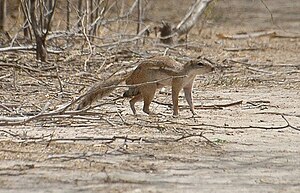Striped bristle cone
| Striped bristle cone | ||||||||||||
|---|---|---|---|---|---|---|---|---|---|---|---|---|

Striped bristle cone |
||||||||||||
| Systematics | ||||||||||||
|
||||||||||||
| Scientific name | ||||||||||||
| Xerus erythropus | ||||||||||||
| ( É. Geoffroy Saint-Hilaire , 1803) |
The striped bristle squirrel ( Xerus erythropus ), also called striped ground squirrel , Tschadziesel squirrel or West squirrel , is a medium-sized member of the squirrel family with a body length of 22 to 30 centimeters and a tail length of 18 to 27 centimeters .
Appearance
Striped bristle squirrels have a brownish coat color on the back and the side of the body. The belly is white. A special feature is a thick elongated stripe on the side of the body, which is set off white at the top and black at the bottom. They have a very smooth, hard coat and hardly any under hair. The head is elongated and rather flat. The rest of the body is narrow and stocky at the back. The long tail is very bushy and very fringed. The front and rear limbs are very strong and have long claws.
distribution and habitat
This species occurs in Africa from Morocco to Kenya and Uganda. She inhabits the forest, bush and savannah areas there.
Way of life and reproduction
The striped bristle squirrel inhabits self-dug underground structures in the savannah with one to two meter long tunnels and several branches. The diurnal animals mainly collect plant seeds, buds, roots and berries in the vicinity of their homes. The very sociable animals greet their conspecifics with "kisses" or tail strokes. The long bushy tail is used by the animals - bent over the body - as a natural parasol. Its natural enemies include larger birds of prey, snakes, ichneumons, and other predators. Mating takes place in March and April. The gestation period of the females is about 4 weeks, after which 3–4 young are usually born.
particularities
In some areas of their area of distribution it is believed that their bite is poisonous, but this is caused by streptococci , which can be found in their salivary glands and can be transmitted with bites.
Hazards and protective measures
Since this species is widespread and no specific threats are known, it is classified by the IUCN as Least Concern .
literature
- The Great World Empire of Animals Publisher: Planet Media AG, Zug 1992 Page: 160, 161 ISBN 3-8247-8614-1
- Wildlife Africa in Color Publisher: Müller, 1989, page: 30
- Enzyklopädie der Säugetiere Verlag: Weltbild, Augsburg 1999 Page: 214 ISBN 3-8289-1556-6
- Enzyklopädie der Säugetiere Verlag: Könnemann 2003 Page: 601 ISBN 3-89731-928-4
Web links
- Xerus erythropus inthe IUCN Red List of Endangered Species 2015.3. Posted by: Grubb, P., Oguge, N. & Ekué, MRM, 2008. Retrieved November 1, 2015.